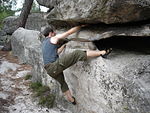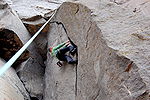- List of climbing techniques
-
Rock climbing History
Styles
Technique
Equipment and protection
Grades (difficulty of climb)
Terminology
Belaying
Abseilingv · posture, movement, or hold used in climbing. In this article, several different climbing techniques are listed, and briefly described. Arm bar, elbow bar
Jamming an arm into a crack and locking it into place.
Bridging, or stemming
Climbing a corner with the legs spread wide apart, one against each face, with the feet relying on friction or very small holds.
Campusing
Campusing describes climbing using only the arms. The word itself is derived from the power training done on a set of campus boards.
Chest jam
Jamming the torso into a wide crack, for resting.
Chimneying
Climbing between opposing rock faces, with the back and hands against one face, and the feet against the other face, or alternating between both.
Crimp, or crimping
Grabbing on to a hold with the fingertips alone.
Dyno
The term is an abbreviation of dynamic maneuver. Using the momentum of a movement or jump to reach a hold beyond your reach. Ideally, gravity brings the movement to a stop at the "deadpoint," i.e., when the hands reach the hold. When using this technique, the climber often leaves all contact with the wall.
Egyptian, or drop knee, or lolotte
Method for reducing tension in arms when holding a side grip. One knee ends up in a lower position with the body twisted towards the other leg. It can give a longer reach as the body and shoulders twist towards a hold.
Egyptian bridging
The same position as bridging, but with one leg in front and one behind the body.
Extremity jams
Jamming involves taking advantage of a body part in a crack for the friction it produces to support a share of body weight.
Hand jams
Whole hand
- Thumb-up hand jam: Jamming the hand in a small crack with the thumb in an upward position, enabling greater reach between holds.
- Thumb-down hand jam: As with the thumb-up hand jam, but with the thumb placed downwards, a less maneuverable but more secure hold.
- Fist jam: Jamming the hand into a crack with a clenched fist position, the expanded muscles securing the hand.
H
Partial hand
- Finger Lock: Inserting fingers from tips to third knuckle and performing a twisting technique to lock the fingers into the crack. There are different ways to lock the fingers depending on crack and finger size.
- Thumb-up or thumb-down finger jam: as with the thumb hand jams above, but using the fingers instead of the hand as a whole.
- Ring jam: used when the crack narrows in the middle but flares out again by placing one finger round the narrow part and the thumb below, thus creating a "ring" hold.
- Thumb lock: for smaller cracks, use by locking the thumb into a crack.
- Pinkie jam: jamming the pinkie (little) finger into the crack.
Jams using feet
Foot jam
This technique is also known as the heel-to-toe jam. It involves jamming the foot into a larger crack by twisting the foot into place, the contact with the crack being on the heel and toes.
Toe jam in a crack
When the foot is too large, the toe jam is used by locking the toes into a crack and lowering the heel.
Flagging
Where one foot is not placed on a foot hold and the leg is held in a position to maintain balance, rather than to support weight. This is often useful to prevent barn-dooring. The flagging foot may be pressed against the wall or may simply hang in space depending on what will best maintain balance.
There are three basic flagging positions
- normal flag - where the flagging foot stays on the same side (e.g. flagging with the right foot out to the right side of the body)
- reverse inside flag - where the flagging foot is crossed in front of the foot that is on a foot hold
- reverse outside flag - where the flagging foot is crossed behind the foot that is on a foot hold
Gaston
Pulling sideways and outwards, akin to opening a pair of sliding doors. The term comes from a story about the climber Gaston Rébuffat, who apparently climbed several difficult cracks in Europe using this hand position.[citation needed] Normally cracks are climbed by jamming hands or fingers—or any part of the body that fits—in the crack to hold oneself.
Heel hook
Using the back of the heel to apply pressure to a hold, for balance or leverage; this technique requires pulling with the heel of a foot by flexing the hamstring. This technique is notable since in most forms of climbing one uses the toes to push.
Holding a grip: tendu or arqué
- Tendu is the French word that means open hand. In this grip the fingers are close to the position when the hand is open. The relative angle between the phalanges is gradual. The load applied is coming from tension in the forearm muscles.
- Arqué is the French word used to describe crimping. In this position typically the first set of knuckles are hyper-extended and the second set have a sharp angle — about 90 degrees. In this position, muscular effort is combined with soft tissue tensions in order to apply the load. This position, when used often, has been known to overstress the tendons in the fingers and lead to injuries.
Laybacking
Climbing a vertical edge by side-pulling the edge with both hands and relying on friction or very small holds for the feet.
Mantling, or mantleshelfing
Boosting upwards using only the arms and ending with arms fully extended downwards. The motion is akin to getting out of a swimming pool without using the ladder.
No-hands rest
Method for resting without using the hands, such as standing on footholds, or using a knee bar (jamming a knee into a large crack).
Smearing
Relying solely upon the friction of a flat surface, usually with the feet, to keep from falling. This is possible primarily due to the sticky rubber soles ubiquitously used in modern climbing shoes.
Toe hook
A toe hook is securing the upper side of the toes on a hold. It helps pull the body inwards—towards the wall. The toe hook is often used on overhanging rock where it helps to keep the body from swinging away from the wall. This technique may also be known as "bat hook".
External links
- climbing.tropic.org.uk has lots of info on climbing techniques
- Rock Climbing UK Features a full section on climbing techniques and training plans.
Categories:- Rock climbing
- Climbing
- Climbing techniques
Wikimedia Foundation. 2010.
Look at other dictionaries:
Climbing Great Buildings — Genre Documentary Presented by Jonathan Foyle Country of origin United Kingdom Language(s) English No. of series … Wikipedia
Climbing — This article is about Human climbing. For climbing in other animals, see Arboreal locomotion. For other uses, see Climbing (disambiguation). Rock climbers on Valkyrie at The Roaches in Staffordshire, England … Wikipedia
List of rodents — The class Mammalia (the mammals) is divided into two subclasses based on reproductive techniques: egg laying mammals (the monotremes); and mammals which give live birth. The latter subclass is divided into two infraclasses: pouched mammals (the… … Wikipedia
Climbing equipment — A wide range of equipment is used during rock climbing. The most popular types of climbing equipment are briefly described in this article. The article on protecting a climb describes equipment commonly used to protect a climber against the… … Wikipedia
List of knot terminology — This page explains commonly used terms related to knots. Contents: A B C D E F G H I J K L M N O P Q R S T U V W X Y Z B … Wikipedia
List of Dragon Ball episodes — First volume of the Dragon Ball DVD series, released by Toei Entertainment on April 4, 2007 Dragon Ball is the first in a trilogy of anime adaptations of the Dragon Ball manga series by Akira Toriyama. Produced by Toei Animation, the anime series … Wikipedia
List of G.I. Joe: A Real American Hero characters: A-C — This is an alphabetical list of G.I. Joe: A Real American Hero characters whose code names start with the letters A C. Contents 1 Ace 2 Agent Faces 3 Airborne … Wikipedia
List of Doctor Who villains — The War Chief redirects here. For the Age of Empires III expansion pack, see Age of Empires III: The War Chiefs. Zaroff redirects here. For the fictional Richard Connell villain, see The Most Dangerous Game. This is a list of villains from the… … Wikipedia
List of doping cases in cycling — The following is an incomplete list of doping cases in cycling, where doping means use of physiological substances or abnormal method to obtain an artificial increase of performance . It is neither a list of shame nor a list of illegality, as the … Wikipedia
List of Dragon Ball characters — Shen Long redirects here. For other uses, see Shenlong (disambiguation). The main cast of Dragon Ball at the end of manga. The … Wikipedia
18+© Academic, 2000-2025- Contact us: Technical Support, Advertising
Dictionaries export, created on PHP, Joomla, Drupal, WordPress, MODx.Share the article and excerpts
List of climbing techniques
- List of climbing techniques



